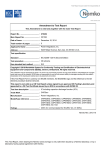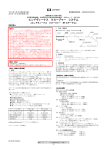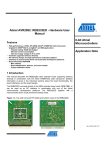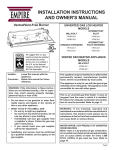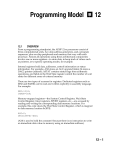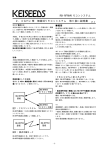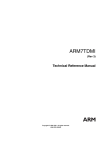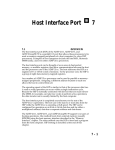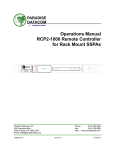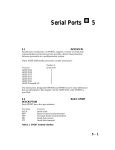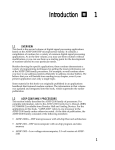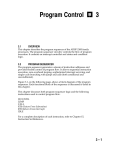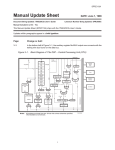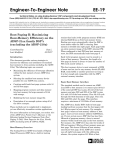Download ADSP-2100 Family User`s Manual, Hardware Examples
Transcript
Hardware Examples
13.1
13
OVERVIEW
This chapter describes some hardware examples of circuits that can be
interfaced to the ADSP-21xx serial ports, host interface port (HIP), or the
memory port. As with any hardware design, it is important that timing
information be carefully analyzed. Therefore, the data sheet for the
particular ADSP-2100 family processor used should be used in addition to
the information presented in this chapter.
13 – 1
13 Hardware Examples
13.2
BOOT LOADING FROM HOST USING BUS REQUEST & GRANT
All ADSP-2100 family processors that have internal program memory
RAM support boot loading. With boot loading, the processor reads
instructions from a byte-wide external memory device (usually an
EPROM) over the memory interface and stores the instructions in the 24bit wide internal program memory. Once the external memory device is
set up to provide bytes in the proper order, the boot operation can run
automatically and transparently at reset or when forced in software. See
Chapter 10, “Memory Interface.”
In some systems where the ADSP-21xx is controlled by a host processor, it
is necessary to boot the DSP directly from the host. In this case the host,
rather than an EPROM, is the source of bytes to be loaded into on-chip
memory. If the ADSP-21xx has a host interface port (such as the ADSP2111), it can perform automatic boot loading through this port. If the
processor does not have a host interface port, however, it can still boot
through the memory interface using the bus request signal, as described
below.
This example shows a simple way to download programs from a host
processor to the internal program memory of an ADSP-21xx. There are
several techniques for connecting a DSP processor to a host. The choice of
which technique to use depends upon the I/O structure of the host,
availability of I/O port lines, and the amount of address decoding logic
already available in the system.
Figure 13.1 illustrates a minimal system implementation to allow a
microcontroller to boot an ADSP-21xx. The only hardware required is a Dtype flip-flop and a 5 kΩ resistor. The resistor is used to pull the ADSP21xx’s BMS pin (Boot Memory Select) high.
The ADSP-21xx automatically enters its booting sequence after the
processor is reset (when the MMAP pin is tied low) or when software
initiates a reboot operation. When the ADSP-21xx begins to fetch a byte
from external boot memory (in this case, the host processor), it asserts
BMS. When BMS goes low, the flip-flop is preset and the Q output
brought low. This low signal asserts BR (bus request) on the ADSP-21xx.
When bus request is recognized by the ADSP-21xx, the current execution
cycle is allowed to finish and then processor operation is suspended. The
ADSP-21xx then asserts BG (bus grant) in the next cycle (after BR is
recognized).
13 – 2
Hardware Examples 13
VDD
5 kΩ
PB8
RESET
BMS
Host
Microcontroller
(Port Bits)
ADSP-21xx
PB9
D
PR
Q
74LS74
PB10
CLK
Q
Can Be Polled
If Necessary
BR
BG
D8-15
PB0-7
8
Figure 13.1 ADSP-21xx Booting From Host
13 – 3
13 Hardware Examples
When a low-level signal at the D input is clocked into the flip-flop, the Q
output is brought high, deasserting BR.
The bus request pin (BR) of the ADSP-21xx is used to stop and
synchronize the booting process. The host releases bus request, causing
the ADSP-21xx to read one byte of boot data. During the read operation
the BMS pin is asserted, which in turn causes the BR pin to be asserted
and the ADSP-21xx to be put back into a bus request state. The ADSP-21xx
remains suspended, waiting for the next byte of boot data.
Three programmable port bits of the microcontroller (PB 8-10) are used to
provide the handshake mechanism for the transfer of each byte of boot
data. Alternately, PB9 and PB10 could be implemented as a memorymapped port location. PB8 is used to bring the ADSP-21xx out of reset,
starting the boot process. Note that if PB8 is not low at power-up, the
ADSP-21xx will start executing undefined instructions until PB8 is
brought low.
The boot data is presented by the microcontroller either through 8 port
bits (PB0-7) or through a memory-mapped port. The PB0-7 bits should be
put into a high-impedance state after the boot is complete, to prevent bus
contention if the ADSP-21xx tries to write to external memories or
peripherals.
A typical boot sequence for this system is as follows:
1.) Bring PB8 low to reset the ADSP-21xx.
2.) Clock a high state into the flip-flop with PB9 and PB10 to bring BR low.
3.) Bring PB8 high to bring the ADSP-21xx out of reset.
4.) Place a byte of boot data on the data bus (PB0-7.).
5.) Clock a low state into the flip-flop with PB9 and PB10 to bring BR high.
6.) Wait a minimum of six processor cycles while the ADSP-21xx fetches
the data byte and the flip-flop asserts BR.
7.) Repeat steps 4, 5, and 6 for each byte of boot data. After the last
iteration, the ADSP-21xx will automatically start execution.
13 – 4
Hardware Examples 13
Note: The proper loading sequence for boot data must be followed (i.e. the
order in which the host passes bytes to the ADSP-21xx). This sequence is
described in the Chapter 10, “Memory Interface.” To create a file for
booting, use the PROM Splitter utility of the ADSP-2100 Family
Development Software. The PROM Splitter automatically organizes the
bytes in the proper order for booting.
13.3
SERIAL PORT TO CODEC INTERFACE
A codec (COder/DECoder) incorporates analog-to-digital conversion,
digital-to-analog conversion, and filtering in one device. The codec shown
in this example also performs pulse-code modulation (PCM) encoding and
decoding according to the CCITT µ-law standard. PCM compresses digital
data so that fewer bits are needed to store the same information. The
ADSP-21xx serial ports have both µ-law and A-law companding
(compressing/expanding) capability.
In the example described here, a codec converts its analog input to digital
data, compresses it and sends it serially to the SPORT on an ADSP-21xx
processor. At the same time, the processor sends compressed serial data
via the SPORT to the codec, which expands the data and converts the
result to an analog signal.
13 – 5
13 Hardware Examples
Figure 13.2 shows an industry standard µ-law companding codec
connected to a serial port (in this case, SPORT0) on an ADSP-21xx
processor. The codec’s analog input at VFXI+ is internally amplified by a
gain which is controlled by the resistor combination at GSX and VFXI–.
The gain is
20 x log (R1 + R2)/R2
in this case, 20 log 2.
The ADSP-21xx controls codec operation by supplying master and bit
clock signals. In the configuration shown, the codec transmit and receive
sections operate synchronously. MCLKR and MCLKX are the master
clocks for the receive and transmit sections of the codec, respectively.
BCLKX is the bit clock and in this configuration is used for clocking both
received and transmitted serial data. MCLKR, MCLKX and BCLKX must
be synchronous and in this case they are the same signal, namely the
SCLK0 output generated by the ADSP-21xx processor. The BCLKR/
CLKSEL input, tied low, selects the frequency of MCLKX to be 2.048 MHz.
The ADSP-21xx must be programmed for internal SCLK0 generation at
2.048 MHz.
BCLKR/CLKSEL
CODEC
(National
Seminconductor
TP3054)
Digital
Ground
MCLKR
MCLKX
FSR
DR
From Input
Amplifier
VFXI+
FSX
DX
To Output
Amplifier
VFRO
Figure 13.2 ADSP-21xx Serial Port (SPORT0) To CODEC
13 – 6
SCLK0
BCLKX
TFS0
DT0
RFS0
DR0
ADSP-21xx
(Serial Port 0)
Hardware Examples 13
The processor uses frame synchronization signals to tell the codec to send
and receive data. To transmit data to the codec, it sends a TFS0 pulse to
the FSR input of the codec and then outputs the eight bits on DT0 on the
next eight serial clock periods. The codec receives the data on its DR input.
Likewise, the processor initiates a data receive operation by sending an
RFS0 pulse to the codec’s FSX input, which causes the codec to output
eight bits on its DX output on the next eight serial clock periods. The
processor receives the data on its DR0 input. The ADSP-21xx must be
programmed to use normal framing, 8-bit data words, and internal, activehigh frame sync generation.
The ADSP-21xx code shown in Listing 13.1 configures SPORT0 for
operation as required in this example:
•
•
•
•
•
•
•
•
Internally generated serial clock
2.048 MHz serial clock frequency
Both transmit and receive frame syncs required
Use normal framing for both transmit and receive
Internally generated transmit and receive frame syncs
Both frame syncs active high
Word length of eight bits
µ-law companding
This code assumes the processor operating at 12.288 MHz. The code also
sets up the processor to request data from the codec at an 8 kHz rate (this
register is not initialized at reset and should always be written before the
SPORT is enabled if RFS is generated internally). The processor transmits
data as needed by the program it is executing.
AX0=0x6927;
DM(0x3FF6)=AX0;
{Int SCLK, RFS/TFS req, norm framing,}
{generate RFS, active HI, Mu-law, word length 8}
AX0=2;
DM(0x3FF5)=AX0;
{value of SCLKDIV for 2.048 MHz}
{with a 12.888 MHz CLKOUT}
AX0=255;
DM(0x3FF4)=AX0;
{RFSDIV=256, 256 SCLKs between}
{frame syncs, 8 kHz framing}
AX0=0x1038;
DM(0x3FFF)=AX0;
{enable SPORT0 only, leave defaults}
Listing 13.1 Serial Port Initialization Example
13 – 7
13 Hardware Examples
13.4
SERIAL PORT TO DAC INTERFACE
Any DSP process must ultimately output analog information. The serial
port of the ADSP-21xx processors can send data directly to a DAC (digitalto-analog converter) for conversion to an analog signal.
Analog Devices’ AD766 is a DAC that requires no extra logic to interface
to the SPORT. The AD766 receives 16-bit data words serially, MSB first,
which it then converts to an analog signal. Its digital interface consists of
three inputs: DATA, the serial data input; CLK, for clocking data into the
DAC (active low because data is clocked on the falling edge) and LE (latch
enable), which latches each 16-bit word into the conversion section of the
DAC.
The serial port connection to the AD766 is shown in Figure 13.3. In this
configuration, the processor generates SCLK internally and provides it to
the DAC. Serial data is output from the DT pin to the DATA input of the
DAC. The TFS signal provides the DAC’s LE input.
ADSP-21xx
AD766
TFS
SPORT
DT
SCLK
LE
DATA
VOUT
CLK
Figure 13.3 Serial Port Interface To AD766 DAC
LE should go low on the clock cycle after the LSB (sixteenth bit) of a word
is transmitted, to latch the 16-bit word into the DAC. To provide this
timing, TFS is configured for the alternate framing mode, non-inverted; it
goes high when the first bit is transmitted and low after the last bit is
transmitted. This low-going edge latches the word into the AD766. The
only restriction is that the SPORT cannot transmit continuously; there
must be a break in between the last bit of one word and the first bit of the
next so that TFS can go low. Figure 13.4 shows the timing.
13 – 8
Hardware Examples 13
SCLK
DT
MSB
LSB
MSB
TFS
Latches data into DAC
Figure 13.4 SPORT To AD766 DAC Timing
The configuration of the SPORT control registers for this application is
shown in Figure 13.5.
SPORT0 Control Register: 0x3FF6
SPORT1 Control Register: 0x3FF2
15
14
13
12
1
11
10
9
1
1
1
8
7
0
6
5
4
3
2
1
0
0
0
1
1
1
1
Word Length = 16 bits
SCLK generated internally
Transmit framing required
Data format = right justify, zero fill
Alternate transmit framing
Non-inverted TFS
Internally generated TFS
Figure 13.5 SPORT To AD766 DAC Control Register Settings
13 – 9
13 Hardware Examples
13.5
SERIAL PORT TO ADC INTERFACE
An ADC (analog-to-digital converter) converts an analog signal to digital
samples that a DSP processor can operate on. The ADSP-21xx processors
can receive data from an ADC directly through a serial port.
Analog Devices’ AD7872 is an ADC that requires no extra logic to
interface to the SPORT. The AD7872 converts an analog signal to 14-bit
samples. Each sample is padded with two zero MSBs to yield 16-bit
samples. The AD7872 outputs each sample serially, MSB first. Its digital
interface consists of three pins: SDATA, the serial data output; SCLK, for
clocking data out; and SSTRB, (serial strobe), which frames each serial
word.
The serial port connection to the AD7872 is shown in Figure 13.6. The
timer regulates sampling via the CONVST input at a constant frequency.
Instead of the timer, an unused serial clock or flag output from the ADSP21xx processor can be programmed to generate the CONVST signal. The
AD7872 generates SCLK internally and provides it to the processor. With
the CONTROL input held at –5 V, the SCLK signal is continuous, running
even when no data is being output.
+5 V
4.7 kΩ
2 kΩ
4.7 kΩ
ADSP-21xx
SPORT
AD7872
RFS
SSTRB
DR
SDATA
SCLK
SCLK
CONVST
CONTROL
Figure 13.6 Serial Port Interface To AD7872 ADC
Serial data is output from the SDATA output of the ADC to the
processor’s DR pin. The SSTRB signal provides the RFS input to the
processor. SSTRB goes low when the first bit is transmitted to the
processor. Figure 13.7 shows the timing of the serial data transfer.
13 – 10
TIMER
–5 V
Hardware Examples 13
SCLK
MSB (0)
DR
0
LSB
RFS
Figure 13.7 SPORT To AD7872 ADC Timing
RFS is configured for the alternate framing mode, externally generated,
with inverted (active low) logic. The SPORT must also be programmed for
external serial clock and a serial word length of 16 bits. The configuration
of the SPORT control register for this application is shown in Figure 13.8.
SPORT0 Control Register: 0x3FF6
SPORT1 Control Register: 0x3FF2
15
14
13
12
0
1
1
11
10
9
8
1
7
6
5
4
3
2
1
0
0
0
0
1
1
1
1
SCLK generated
externally
Receive framing
required
Word Length = 16 bits
Data format = right justify, zero fill
Alternate receive
framing
Inverted RFS
Internally
generated RFS
Figure 13.8 SPORT To AD7872 ADC Control Register Settings
13 – 11
13 Hardware Examples
13.6
SERIAL PORT TO SERIAL PORT INTERFACE
The serial ports provide a convenient way to transfer data between ADSP21xx processors without using external memory or the memory bus and
without halting either processor. The serial ports are connected as shown
in Figure 13.9—in this example, SPORT1 of processor #1 is connected to
SPORT0 of processor #2.
The serial clock used by both processors is generated internally by
processor #1. Processor #2 is configured to receive its serial clock
externally. The serial port control registers should be set up with the
following parameters.
Processor 1, SPORT1
Processor 2, SPORT0
SCLKDIV = system-dependent
SLEN = system-dependent
ISCLK = 1
TFSR = 1
RFSR = 1
IRFS = 0
ITFS = 1
RFSDIV = don’t care
SCLKDIV = system-dependent
SLEN = system-dependent
ISCLK = 0
TFSR = 1
RFSR = 1
IRFS = 0
ITFS = 1
RFSDIV = don’t care
TFSW1 = RFSW1 = TFSW2 = RFSW2 = system-dependent
INVRFS1 = INVTFS1 = INVRFS2 = INVTFS2 = system-dependent
ADSP-21xx
#1
SPORT1
RFS1
TFS0
TFS1
RFS0
DT1
DR0
DR1
DT0
SCLK1
SPORT0
ADSP-21xx
#2
SCLK0
Figure 13.9 Serial Port Interface Between Two ADSP-21xx Processors
Frame synchronization is used to coordinate the transfer of serial data.
Each processor generates a transmit frame sync (TFS) signal internally and
expects to receive its receive frame sync (RFS) signal externally, from the
other processor. The framing mode can be normal or alternate, but must
be the same for both SPORTs. Likewise, the SPORTs must be configured
for the same serial word length and companding type, if companding is
used, or data format if companding is not used.
13 – 12
Hardware Examples 13
The autobuffering capability of the serial ports can be used in this
configuration to transfer an entire buffer of data from the data memory
space of one processor to the other’s, without interrupt overhead. The serial
ports handshake automatically—when one processor writes its’ TX0
register, the data is automatically transmitted to the other processor’s RX0
register and an autobuffer cycle is generated.
In fact, autobuffer transfers can occur in both directions at the same time,
in the background, while each processor is executing some other primary
function. Each SPORT will generate an interrupt when the autobuffer
transfer is complete. The description of autobuffering in the Serial Port
chapter shows an example of the code for setting up autobuffering.
13.7
80C51 INTERFACE TO HOST INTERFACE PORT
The host interface port (HIP) on the ADSP-2111, ADSP-2171, and ADSP21msp5x processors facilitates communication with a host microcomputer
such as the Intel 80C51. An example connection is shown in Figure 13.10.
In this example, the HIP data registers (HDRs) and HIP status registers
(HSRs) of the ADSP-2111 occupy eight contiguous locations in the
memory space of the 80C51.
HSEL
ADSP-21xx
ADSP-2111
8
P2.0-2.7
ALE
ALE
HRD
RD
HWR
WR
HAD0-7
HMD0
ADDRESS
DECODE
HMD1
HSIZE
+5 V
+5 V
8
80C51
P0.0-0.7
Figure 13.10 Host Port Interface to 80C51 Microcomputer
13 – 13
13 Hardware Examples
To access one of the HIP registers, the 80C51 asserts ALE and outputs a
16-bit address, with the upper half on P2.0-2.7 and the lower half on
P0.0-0.7. The upper half is decoded to select the HIP via HSEL, and the
lower half selects the HIP register via HAD0-7. The ALE assertion causes
the HIP to latch the address so that the 8-bit data can then be transferred
on the HAD0-7 lines. The 80C51 asserts WR for a write or RD for a read.
In this example, the 80C51 reads and writes 8-bit data, so the ADSP-2111’s
HSIZE input is tied high. Only the lower eight bits of each HIP register are
used. HMD0 is tied low because the 80C51 uses separate read and write
strobes rather than a single Read/Write line. HMD1 is tied high because
the address and data use the same bus (time-multiplexed using ALE)
rather than separate buses.
13 – 14















